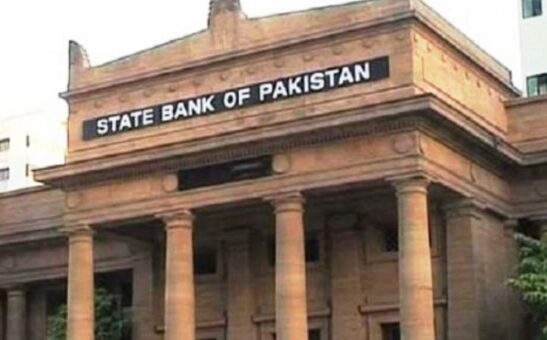KARACHI: The State Bank of Pakistan (SBP) on Thursday announced to further cut policy rate by 100 basis points to 7 percent in order to support domestic economic activities.
A statement issued by the SBP stated that at its meeting on June 25, 2020, the Monetary Policy Committee (MPC) decided to reduce the policy rate by 100 basis points to 7 percent. This decision reflected the MPC’s view that the inflation outlook has improved further, while the domestic economic slowdown continues and downside risks to growth have increased.
Against this backdrop of receding demand-side inflation risks, the priority of monetary policy has appropriately shifted toward supporting growth and employment during these challenging times.
Consistent with its mandate, the MPC re-asserted its commitment to supporting households and businesses through the Covid-19 crisis and minimizing damage to the economy. In this context, the MPC felt that from a risk management point of view, a prompt response to downside risks to growth was called for given the improved inflation outlook. In addition, the MPC noted that with approximately Rs. 3.3 trillion worth of loans due to be repriced by early July 2020, this was an opportune moment to take action from a monetary policy transmission perspective.
In this way, the benefits of interest rate reductions would be passed on in a timely manner to households and businesses.
The MPC noted that the Covid-19 pandemic is spreading in many emerging markets, including Pakistan, and there are fears of a second wave in several other countries.
The MPC observed that risks to the global outlook are heavily skewed to the downside and the path of recovery remains uncertain.
The MPC also noted that in its update of the World Economic Outlook (WEO) released yesterday, the IMF downgraded its 2020 global growth forecast further to -4.9 percent, 1.9 percentage points lower than in April, and projected a more gradual recovery than previously anticipated.
Domestically, the moderation of underlying inflation has continued. Notwithstanding a seasonal uptick in food prices associated with the Eid holiday, headline inflation declined further to 8.2 percent in May on the back of the recent cut in diesel and petrol prices. In addition, month-on-month inflation rates continue to be low.
Recent SPI data also suggests continued moderation in overall price pressures in June, despite price increases in some food items, notably wheat.
The FY2020/21 budget is also expected to be neutral for inflation as the freeze on government salaries, absence of new taxes, and lower production cost from reduced import duties should offset the decline in subsidies in some sectors. While supply shocks could create some volatility in inflation, the MPC felt that these are likely to be transitory given weak domestic demand, such that monetary policy should generally look past them.
Given the absence of demand-side pressures, average inflation could fall below the previously announced range of 7-9 percent for next fiscal year.
With the current reduction of the policy rate to 7 percent, the MPC felt that real rates on a forward-looking basis (defined as the policy rate less expected inflation) would be kept close to zero, which is appropriate under the current circumstances.
On the real side, the decline in LSM deepened to 41.9 percent (y/y) in April, when lockdowns were still in place. In May, high-frequency indicators of activity such as cement dispatches, automobile sales, food and textile exports, and POL sales also continued to contract, although mostly at a lower rate than in the previous two months. Looking ahead, the economy is expected to recover gradually in FY21, supported by easing lockdowns, supportive macroeconomic policies and a pick-up in global growth. However, risks are skewed to the downside and the recovery will depend critically on the evolution of the pandemic both in Pakistan and abroad.
On the external front, the current account swung into surplus in May on the back of a reduction in the trade deficit and a pick-up in remittances compared to the previous month. Meanwhile, portfolio outflows slowed considerably compared to the previous two months and FDI has been resilient, nearly doubling to $2.4 billion so far in FY20 compared to the same period last year. SBP reserves declined to US$ 9.96 billion as of 19th June 2020 largely due to debt repayments.
However, since then, SBP has received fresh disbursements from multilateral agencies including around $725 million from World Bank and $500 million from ADB, and another $500 million is expected shortly from the Asian Infrastructure Investment Bank (AIIB).
During this period of external volatility, the MPC observed that the flexible exchange rate has played its valuable shock absorber role, helping cushion the economy from the tightening of financial conditions associated with capital outflows from emerging markets and deteriorating global sentiment.
The MPC noted that the depreciation in the rupee has been lower than in many other emerging markets, reflecting the increased reserve buffers accumulated over the last year. The outlook for the external sector remains stable. Recent data confirms the view that the current account deficit should remain bounded through the Covid-19 crisis due to lower oil prices. In addition, projected official and private inflows are expected to keep the external position fully funded.
Today’s decision brings the cumulative reduction in the policy rate since mid-March to 625 basis points, commensurate with the decline in inflation during this period.
The MPC noted that the take-up of several other SBP initiatives has risen significantly in recent weeks, notably concessional refinancing facilities to protect employment and support the health sector as well as regulatory measures to provide debt servicing relief.
Together, this strong and data-driven monetary policy response should support growth and employment, while keeping inflation expectations anchored and maintaining financial stability.
